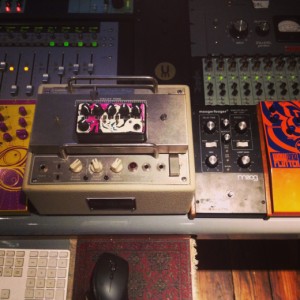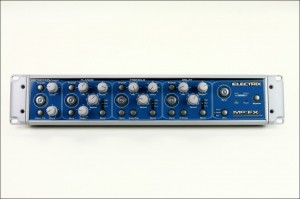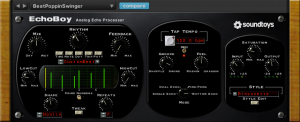My GO TO…Delay: Three Pros Share Their Secret Weapons
First in a series, where busy producers/mixers/engineers provide tips and techniques on their top studio tools.
When it comes to gear, engineers, producers and musicians are creatures of habit. When I find a piece of gear, or a plug-in with a killer sound that works consistently from project to project, I stick with it.
It’s when I’m forced out of my comfort zone by working in an unfamiliar studio environment, or perhaps by an artist or co-producer who has fresh ideas on how to achieve a particular sound that I often do my best work. I always love finding new tools and new approaches to sound.
This column is the first in a series of pieces where we will focus on a particular tool for recording and mixing and bring you some tips and tricks on how to make it work in your mixes.
We’ll also survey a few engineers and producers to get their unique insight into their favorites and how they like use them!
Today’s feature: Delay.
Delay is one of my favorite effects to work with in mixes because of its sheer versatility. Delay can add space and ambience to a dry guitar, accent a word or phrase of a vocal, or even artificially create the effect of a doubled track.
When I first started making my way through the studio ranks, hardware staples like the Lexicon PCM 42, TC 2290 and AMS DMX were in nearly every control room. Before my time, tape delay was prominent in the 1950’s and 60’s with artists like Elvis and The Beatles using the actual heads on a tape machine to create a delayed slap back sound.
In the 70’s and 80’s, hardware boxes like the Roland Space Echo were all the rage in studios and used by many classic artists like Pink Floyd and Radiohead.
Gradually, as software effects became more and more ubiquitous with recording, certain plug-ins became the go to for many engineers. Among the favorites from the last ten years would be Line 6’s Echofarm, Waves Supertap, PSP’s 85 and 608 and my go to delay currently: SoundToys EchoBoy.
The reason I like EchoBoy so much is that on any given mix, it can be anything I want it to be. Lately, I’ve been gravitating towards a preset called “HallwayVocal” which combines a heavily diffused “splattered” sound with a very short stereo slap.
The resulting sound, when carefully blended, creates a lush stereo presence for my lead vocal without being overly obvious that it’s even a delay.
Hear Zach McNees’ use of Echoboy “HallwayVocal” preset on the song “Magnolia” by Ali Hoffman, followed by the full mastered version of the track.
So what is everyone else doing with delay these days? I’ve spoken with Engineers Brian Bender, Kevin Killen, and Jason Finkel about some of their favorite delay units and how they like to use them.
GO TO PRO #1: Brian Bender
Brian Bender and I were colleagues at The Hit Factory here in New York prior to its close. Since then, Brian has been quite busy at his own facility The Motherbrain in Sunset Park Brooklyn cranking out some of the tastiest records I’ve ever heard. Recent highlights include the last Jose James record “No Beginning, No End” (co-produced with Pino Palladino), Langhorne Slim and the Law, Krystle Warren, Kris Bowers, Takuya Kuroda and Sister Sparrow and the Dirty Birds.

Brian Bender’s delays: FullTone Tube Tape Echo, the square wave parade – Teaspoon, cream and sugar edition
Moog Moogerfooger mf-104z (click to enlarge)
Snazzy FX – wow and flutter
Brian’s GO TO delay: The Fulltone Tube Tape Echo. For those not familiar, the “TTE” as it’s commonly referred is essentially a tiny tape machine built just for echo.
Guitar players and engineers alike use the TTE for it’s lush, analog sound. The TTE is the real thing and Fulltone does not take kindly to their emulating competitors! Fulltone’s mission statement for the Tube Tape Echo states:
“There is nothing funnier than the makers of this new wave of digital and chip-based delays claiming to ‘sound like a tape echo.’ One after another they pop out the same old digital and bucket-bridgate delays that supposedly “emulate the warble and tape head saturation of a tape echo” …Bull$#^%.”
I thought this was a perfect lead in for Brian Bender who’s nothing if not a zero Bull$#^% kind of guy.
“It’s just the fucking best.” Brian says of the TTE. “It sounds amazing and the build quality is amazing. It’s super stable, has flexible controls: independent dry/wet volumes, a record trim for tape saturation, a tilt EQ, swell, and wide range of delay times thanks to its moving head, a la an Echoplex, and two tape speeds.
I use it all the time for slap echoes, especially for vocals, drums, and guitar. And, if you’ve smoked enough weed, it’s endless fun times with King Tubby style dub moments. The classic huge forever swell that goes achingly into feedback, weird pitch artifacting from moving the head or changing the speed or even putting something on the pinch roller to get into chorusing/wow flutter territory.
The addition of the EQ option makes it incredibly useful on tons of sources. You can really change the way the delay sits in the mix, forward to back, just by chilling out the midrange a little with the EQ / input saturation. Check out “Hambone” by Heather Christian and the Arbornauts. The end of that tune is me feeding back the whole mix into the TTE and then manually stopping the capstan with my finger in order to get that full stop effect. Endless fun.”

Why are you gravitating towards the TTE and what’s a cool tip or trick you can share with us about it? “As I mentioned before, one of the ways in which the TTE gets the most love in my arsenal is as a slap echo.
Set up an aux send off the track you want to slap around, send out to the TTE and back into your mixer or DAW. I almost always make it a parallel send so I have independent controls over the volume and timbre of each. I find that a range of between 80-120 ms puts you right there in classic slap territory.
One thing that most folks don’t seem to think of when they think of slap is being subtle with it. I love to get a happening slap together and just bury it in the mix. This can really widen/mellow big transients in a very useful way as well as offer a vocal process that sounds and impacts as quite dry, just a little special. Or, go total instant karma and crank that mf’er and hard pan it. Solid gold Lennon vibes.
Also, very very short slaps, 5-20 MS can be incredibly useful as stereo wideners too if you’re getting bored with harmonizer kinds of options.
Another really great delay that I actually reach for almost as much as my TTE is the Massey TD-5. It is similarly flexible and, especially for digital, really has a special thing. If you want that tape echo thing but don’t wanna drop the coin on a Fulltone or vintage equivalent, the Massey is a super sick way to get that kind of thing happening.”
Thanks Brian!
GO TO Pro #2: Kevin Killen
Our next Delay enthusiast is Kevin Killen. Kevin is a GRAMMY-winning producer/engineer/mixer whose work is known worldwide (see the SonicScoop feature on his work with U2). Featured artists include Peter Gabirel, Elvis Costello, U2, Kate Bush, Jewel, Bon Jovi and many more.
Most recently he’s worked with Goodby Motel (“If”), Suzanne Vega (“Queen of Pentacles”), and Fake Club (“Fuckable”).
Kevin’s GO TO delay is a combo pack. In hardware land, Kevin’s picks are the Electrix Mo-Fx, TC 2290 and Eventide 3500. In the box, Kevin gravitates towards EchoBoy and Echofarm.
Why are you gravitating towards the Electrix Mo-Fx and what is a good tip or trick you can share with us? “The Mo-Fx is just a brilliant box, which has so much personality. I have yet to find an instrument that does not take to its colorful manipulation. I will often have my favorite hardware delays setup for tracking and will randomly push an instrument through the Mo-Fx , 2290 or Eventide. Sometimes I will use all three in series just to create a new sound and inspire the collective.
The Mo-Fx is especially great on drums for rhythmic delays with distortion – instantaneous hit maker.
The 2290 is wonderful on vocals, keys and of course guitar.
The H3500 presents an endless myriad of patches to alter or enhance a sound, especially when one gets into pitch shifting and resonance control.
I like to record all my effects to tape / DAW. By imposing a unique sound from the rhythm section up, it tends to inform every other part and performance. It is not unusual for me to use little effects while I am mixing.”
GO TO Pro #3: Jason Finkel
Jason Finkel is a Brooklyn Based producer/engineer/mixer. Some of his recent work includes Hundred Waters, ARMS, Little Racer, Friend Roulette and The Living Statues.
Jason’s GO TO delay? “The conversation for most people starts and ends with Echoboy, it does with me as well. Though I also like the TD5 from Massey and the Tel Ray (Avid),” Jason says.
Why are you gravitating towards EchoBoy? “Aside from your normal delay duties, I really have been into using tight slaps with the HF and LF cut pretty high up. I like to give a touch of ripple or edge to a vocal or instrument. I don’t think you recognize it as a delay…it gives texture, and the more you blend in the more it thins out the sound, which may be helpful.
Although, you can turn the mix almost all the way to dry and turn up the output and bring back the delay without effecting your dry — which is super cool — I end up just really cranking the thing until I get it to make my vocal pop. I’m also really into automating the plugin, changing the feedback from section to section or muting for vowels etc… It’s usually not set-it-and-forget-it.”
What is a good tip or trick you can share with us? “I like the studio tape stuff for clear tight delays, the Electro-Harmonix Memory Man flavor for textural non-classic stuff because it’s pretty dark. I also like Space Echo or Echoplex for keys or guitars, and sometimes vocals but it will lo-fi up a source quick.
I like a Tel Ray style or super tight slap with LF cut pretty high for bass — I don’t like to double up sub or low frequencies. Tel Ray or oil can stuff is cool on drums. Really, I’ll flip through tons of sounds to get the color to sit well in the mix before I start thinking about EQing the delay.”
Thanks Jason!
Don’t Delay…Start Delaying
As is the case with many facets of audio production, when it comes to delay, anything goes! Get creative with the tools you have access to or branch out and try something new. Crank up the input, experiment with filtering, use your delay to color another effect in the chain, or just find a tasty slap and bury into your mix as an invisible sweetener.
Thanks to Brian, Kevin and Jason for their brilliant insights!
Zach McNees is a Brooklyn-based producer/engineer/mixer and live recordist who’s worked with Björk, Rob Thomas, Julia Nunes, The Gregory Brothers, Pixies, Liars and Alice Cooper. Get in touch with Zach via http://www.zachmcnees.com.
For more great insights into both mixing and mastering, try our full-length courses with SonicScoop editor Justin Colletti, Mixing Breakthroughs and Mastering Demystified.


Please note: When you buy products through links on this page, we may earn an affiliate commission.










j w
April 23, 2014 at 8:55 pm (11 years ago)nice
Supercapital
April 24, 2014 at 10:09 am (11 years ago)Valhalla UberMod!